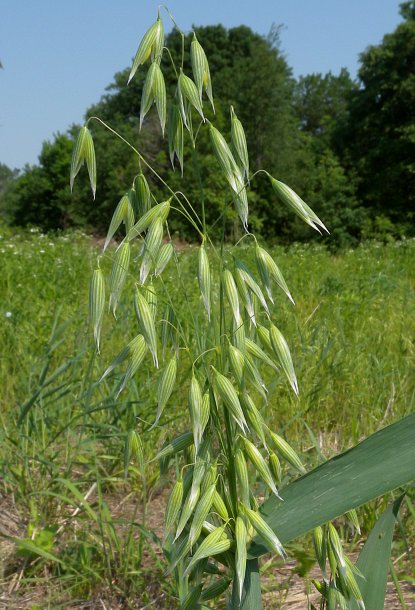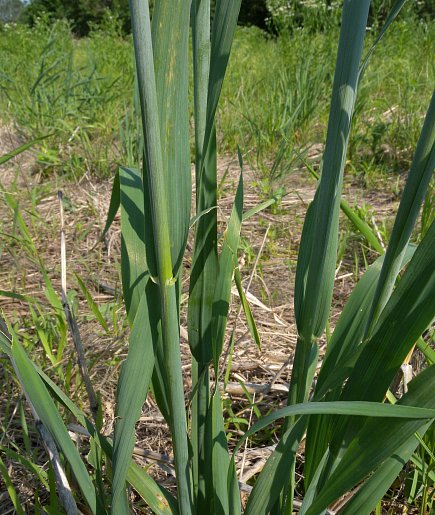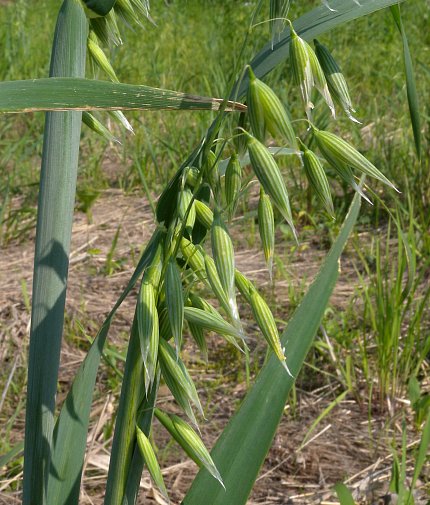
The blooming period occurs from late spring to mid-summer and lasts 1-2 weeks. The florets are either cross-pollinated by the wind or self-fertile. The florets of the lemmas develop into ripened grains later in the summer or fall. These grains are narrowly ellipsoid and narrowly furrowed along one side; they are a little shorter than the lemmas. The root system is shallow and fibrous.
Cultivation: Oats will adapt to full sun, moist to dry conditions, and either barren or fertile soil containing loam, clay, gravel, etc. It develops quickly during the cool moist weather of spring.
Range & Habitat: Oats naturalizes occasionally throughout Illinois, although it rarely persists for more than a few generations (see Distribution Map). This non-native grass was introduced from Europe into North America for agricultural purposes. Habitats consist of cropland, abandoned fields, roadsides, areas along railroads, and areas near grain elevators. Highly disturbed habitats with exposed open ground are preferred. Oats is still cultivated as a source of grain, forage, and straw. It is also used for erosion-control purposes along roadsides and others areas.

Faunal Associations: Various insects feed on oats (Avena sativa). These species include the caterpillars of such moths as Agrotis venerabilis (Venerable Dart), Apamea sordens (Rustic Shoulder-Knot), and Xestia c-nigrum (Lesser Black-Letter Dart). Other insect feeders include: Chaetocnema denticulata (Toothed Flea Beetle), Chaetocnema pulicaria (Corn Flea Beetle), Diabrotica barberi (Northern Corn Rootworm), Oulema melanopus (Cereal Leaf Beetle), and Sphenophorus maidis (Maize Billbug); Melanoplus femurrubrum (Red-Legged Grasshopper) and Melanoplus sanguinipes (Migratory Grasshopper); Aphis middletonii (Erigeron Root Aphid), Forda marginata, Geoica squamosa, Rhopalosiphum padi (Cherry/Oat Aphid), Schizaphis gramineum (Greenbug), and Sitobion avenae (English Grain Aphid); and the plant bug Trigonotylus ruficornis. Many upland gamebirds and granivorous songbirds eat the seeds of oats (see Bird Table), while the Canada Goose consumes both the foliage and seedheads. Both the foliage and seeds of oats are occasionally used to feed domesticated farm animals, particularly horses. For a grass species, the seeds of oats have relatively high protein content.

Photographic Location: A field in Urbana, Illinois.
Comments: Oats is fairly ornamental in appearance. Nonetheless, it is not used in horticulture very often because its annual life cycle makes it more difficult to maintain in the garden than a perennial grass with ornamental properties. Because of its large distinctive spikelets, Oats is fairly easy to identify as a grass. It superficially resembles one of the Brome grasses (Bromus spp.), but the spikelets of the latter have more lemmas that are plainly visible above the glumes. Another introduced grass that is slightly more weedy, Wild Oats (Avena fatua), also occurs in Illinois. It is similar in appearance to the cultivated Oats that is described here. Wild Oats can be distinguished by its pubescent lemmas, crooked awns of its lemmas, and more narrow leaf blades (less than 10 mm. across).